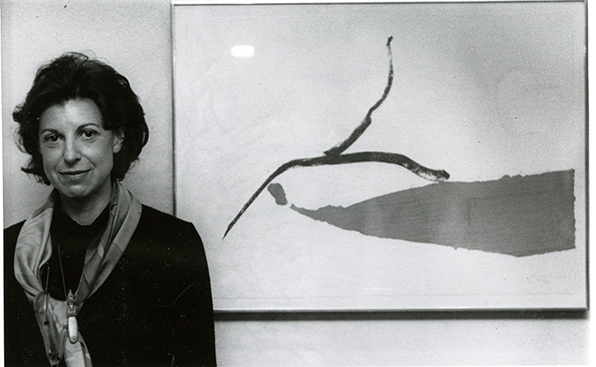
JULY 1–SEPTEMBER 24, 2017
ABOUT THE ARTIST
Helen Frankenthaler (American, 1928–2011), pictured here with a work titled A Little Zen (1970), at the opening reception of Helen Frankenthaler Prints: 1960–1979 at the Clark Art Institute, April 11, 1980. Clark Art Institute Archives
Helen Frankenthaler (1928–2011), whose career spanned six decades, has long been recognized as one of the great American artists of the twentieth century. She was eminent among the second generation of postwar American abstract painters and is widely credited for playing a pivotal role in the transition from Abstract Expressionism to Color Field painting. Through her invention of the soak-stain technique, she expanded the possibilities of abstract painting, while at times referencing figuration and landscape in unique ways. She produced a body of work whose impact on contemporary art has been profound and continues to grow.
Frankenthaler, daughter of New York State Supreme Court Justice Alfred Frankenthaler and his wife, Martha (Lowenstein) Frankenthaler, was born on December 12, 1928, and raised in New York City. She attended the Dalton School, where she received her earliest art instruction from Rufino Tamayo. In 1949, she graduated from Bennington College, where she was a student of Paul Feeley, following which she studied briefly with Hans Hofmann.
Frankenthaler’s professional exhibition career began in 1950, when Adolph Gottlieb selected her painting Beach (1950) for inclusion in the exhibition titled Fifteen Unknowns: Selected by Artists of the Kootz Gallery. Her first solo exhibition was presented in 1951, at New York’s Tibor de Nagy Gallery, and she was also included that year in the landmark exhibition 9th St. Exhibition of Paintings and Sculpture. Renowned art critic Clement Greenberg recognized her originality, and as early as 1959 she began to be a regular presence in major international exhibitions. She had her first museum retrospective in 1960 at The Jewish Museum in New York City.
In 1952 Frankenthaler created Mountains and Sea, a seminal, breakthrough painting of American abstraction. Pioneering the “stain” painting technique, she poured thinned paint directly onto raw, unprimed canvas laid on the studio floor, working from all sides to create floating fields of translucent color. Mountains and Sea was immediately influential for the artists who formed the Color Field school of painting, notable among them Morris Louis and Kenneth Noland. Thereafter, Frankenthaler remained a defining force in the development of American painting.
Throughout her long career, Frankenthaler experimented tirelessly, and, in addition to unique paintings on canvas and paper, she worked in a wide range of media, including ceramics, sculpture, tapestry, and especially printmaking. Hers was a significant voice in the mid-century “print renaissance” among American abstract painters, and she is particularly renowned for her woodcuts. She continued working productively through the opening years of this century.
Frankenthaler’s distinguished and prolific career has been the subject of numerous monographic museum exhibitions. In addition to scholarly articles on her work by renowned art historians, curators, and critics, Frankenthaler was the subject of three major monographs: Frankenthaler, by Barbara Rose (1972); Frankenthaler, by John Elderfield (1989); and Frankenthaler: A Catalogue Raisonné, Prints 1961–1994, by Suzanne Boorsch and Pegram Harrison (1996); and substantial exhibition catalogues by authors including Carl Belz, Julia Brown, E.A. Carmean, Jr., Bonnie Clearwater, Ruth Fine, Judith Goldman, Eugene C. Goossen, Frank O’Hara, and Karen Wilkin. In 2015 Gagosian Gallery published “The heroine Paint”: After Frankenthaler, edited by art historian and curator Katy Siegel, which explores Frankenthaler’s painting and expands its focus to include the immediate social and artistic context of her work, then traces artistic currents as they move outward in different directions in the ensuing decades.
Frankenthaler was the recipient of many honorary doctorates, honors, and awards. In 1966, along with Ellsworth Kelly, Roy Lichtenstein, and Jules Olitski, she represented the U.S. at the 33rd Venice Biennale. She received the National Medal of Arts in 2001; served on the National Council on the Arts of the National Endowment for the Arts from 1985 to 1992; was a member of the American Academy of Arts and Letters (1974–2011), where she served as Vice-Chancellor in 1991; and was appointed an Honorary Academician of the Royal Academy of Arts, London, in 2011.
Important works by Frankenthaler may be found in major museums worldwide. For more information, visit www.frankenthalerfoundation.org.
HELEN FRANKENTHALER AND THE BERKSHIRES
Although well known as part of a group of artists living and working in New York City in the 1950s and ’60s, Helen Frankenthaler was drawn to the Berkshires and surrounding areas throughout her life. In 1945, she enrolled at Bennington College in Bennington, Vermont, then a women’s college. After graduating in 1949, she participated in a group show at the college in 1953, followed by a solo show in 1962. In 1976 she spoke at the dedication of a new arts building, recalling her education fondly. In April 2015, the college named the visual arts wing the Helen Frankenthaler Visual Arts Center, in her honor.
While she undoubtedly had some exposure to the nearby and then all-male Williams College and its museum, she had already graduated and moved to New York before the Clark Art Institute opened its doors in 1955. She returned in 1979, spending the academic year at Williams College as an artist-in-residence. A retrospective of her prints was shown at the Clark the next year (Helen Frankenthaler Prints: 1961–1979); the exhibition also traveled to four other museums nationwide. With the return of some of the artist’s greatest woodblock prints to the Clark, No Rules adds another chapter to the artist’s ongoing story in the region.

